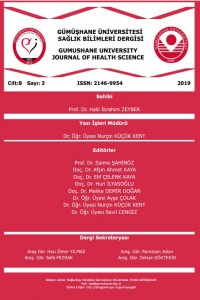Abstract
Bu çalışmada, kan dolaşımı
bozukluğu nedeni ile ortaya çıkan venöz bacak ülseri tedavisinde hastalara
uygulanan negatif basınçlı pansumanın yara iyileşmesi üzerine etkisinin belirlenmesi
amaçlandı. Kesitsel- tanımlayıcı olan bu araştırma, bir üniversite hastanesinin
kalp damar cerrahisi kliniğine venöz bacak ülseri tanısı ile gelen ve araştırma
kriterlerine uyan 21 hasta ile yürütüldü. Araştırmada ’Tanıtıcı Özellikleri
Belirleme Formu’ kullanıldı ve takip kriteri olarak yara alanında azalma ile
yara iyileşmesi baz alındı. Negatif basınçlı pansuman uygulanan hastaların yara
boyutlarında küçülme, yara sekresyonunda azalma, granülasyon dokusu gelişiminde
artma tespit edildi. Tedavi öncesi yara alanının ortalaması 47.4cm2
ve tedavi sonrası yara alanının ortalaması 29.7cm2 olarak
hesaplandı. Yara boyutlarında ortalama %20.2 oranında azalma olduğu saptandı. Negatif
basınçlı pansuman tedavisinin, venöz
bacak ülseri tedavisinde iyileşmeyi hızlandıran, granülasyon ve yara
kontraksiyonunu artıran, cerrahi girişim öncesi bir ara tedavi seçeneği olduğu
belirlendi.
References
- 1. Tan, J, Smith, A, Abisi, S, Etham, D, Burnand, KG. (2007). “Tissue and Urinary Haemosiderin in Chronic Leg Ulcers.” Eur J Vasc Endovasc Surg, 34, 355-360.2. Demirkan, F. (2007). “Kronik Yarada Plastik Cerrahi Yaklaşımı ve Tedavi.” 2. Ulusal Yara Bakımı Kongre Bildiri Özet Kitabı (21-22). İstanbul.3. Mendonca, DA. (2006). “Negative pressure wound therapy: an important adjunct to wound care.” South Med J, 99, 562-563.4. Armstrong, DG, Lavery, LA, Boulton, AJ. (2007). “Negative pressure wound therapy via vacuum-assisted closure following partial foot amputation: what is the role of wound chronicity?” Int Wound J, 4, 79-86.5. Morykwas, MJ, Kennedy, A, Argenta, JP, Argenta, LC. (1999). ”Use of subatmospheric pressure to prevent doxorubicin extravasation ulcers in a swine model.” J Surg Oncol, 72, 14-17.6. Collier, M. (1997). “Know how: Vacuum-assisted closure (VAC).” Nurs Times, 93, 32-33.7. Argenta, PA, Rahaman, J, Gretz, HF, Nezhat, F, Cohen, CJ. (2002). “Vacuum-assisted closure in the treatment of complex gynecologic wound failures.” Obstet Gynecol, 99, 497-501.8. Miller, MS, Brown, R. (2005). “Using Negative Pressure for Wound Therapy Poditary management.” APWCA, 3, 121-126.9. Von Gossler, CM, Horch, RE. (2000). “Rapid aggressive soft-tissue necrosis after beetle bite can be treated by radical necrectomy and vacuum suction-assisted closure.” J Cutan Med Surg, 4, 219-222.10. Dorothy, B, Daughty, MN. (2004). “Wound assessment: tips and techniques.” Home Healthcare Nurse, 22(3), 192-195.11. Aygün, H, Çakar, A, Atilla, HA, Irlayıcı, TB, Aytekin, MN, Ağır İ, İslam C. (2013). “Zor İyileşen Alt Ekstremite Yaralarının Tedavisinde Negatif Basınçlı Yara Tedavi Yönteminin Etkinliği ve Sonuçları.” Ankara Medical Journal, 13(1),16-21.12. Campbell, PE. (2006). “Surgical wound case studies with the versatile 1 wound vacuum system for negative pressure wound therapy.” J Wound Ostomy Continence Nurs, 33, 176-185.13. Bosanquet, N. (1992). “Cost of venous ulcers from maintenance therapy to investment programme.” Phlebol, 1, 44-46.14. Korkmaz, F. (2011). “Topical Negative Pressure Therapy in Care of Pressure Ulcer.” Hacettepe University Faculty of Health Sciences Nursing Journal, 93-102. 15. Wackenfors, A, Sjögren, J, Gustafsson, R, Algotsson, L, Ingemansson, R, Malmsjö, M. (2004). “Effects of vacuum-assisted closure therapy on inguinal wound edge microvascular blood flow.” Wound Repair Regen, 12, 600-606.16. Coggrave, M, West, H, Leonard, B. (2002). “Topical negative pressure for pressure ulcer management.” British Journal of Nursing, 116, 29-36. 17. Ferreira, MC, Wada, A, Tuma, P. (2003). “The Vacuum assisted closure of complex wounds: report of 3 cases.” Revista do Hospital das Clinicas Faculdade de Medicina Sao Paulo, 58(4), 227-230. 18. Gwan-Nulla, DN, Casal, RS. (2001). “Toxic shock syndrome associated with the use of the vacuum-assisted closure device.” Ann Plast Surg, 47, 552-554.19. Tang, AT, Ohri, SK, Haw, MP. (2000). “Novel application of vacuum assisted closure technique to the treatment of sternotomy wound infection.” Eur J Cardiothorac Surg, 17, 482-484.20. Braakenburg, A, Obdeijn, MC, Feitz, R, Van Rooij, IA, Van Griethuysen, AJ, Klinkenbijl, JH. (2006). “The clinical efficacy and cost effectiveness of the vacuum-assisted closure technique in the management of acute and chronic wounds: A randomized controlled trial.” Plast Reconstr Surg, 118, 390-397.21. Joseph, E, Hamori, CA, Bergman, S, Roaf, E, Swann, NF, Anastasi, GW. (2000). “New therapeutic approaches in wound care. A prospective randomized trial of TNBTuum-assisted closure versus Standard therapy of chronic nonhealing wounds.” Wounds, 12(3), 60-67.22. McCallon, SK, Knight, CA, Valiulus, JP, Cunningham, MW, McCulloch, JM, Farinas, LP. (2000). “Vacuum-assisted closure versus saline moistened gauze in the healing of postoperative diabetic foot wounds.” Ostomy Wound Management, 46(8), 28-34.23. Moues, CM, Van Den Bemd, GJ, Heule, F, Hovius, SE. (2007). “Comparing conventionel gauze therapy to Vacum-assisted closure wound therapy: a prospective randomised trial.” Journal of Plastic, Reconstructive and Aesthetic Surgery, 60(6), 672-681.24. Müllner, T, Mrkonjic, L, Kwasny, O, Vecsei, V. (1997). “The use of negative pressure to promote the healing of tissue defects a clinical trial using the TNBTuum sealing technique.” British Journal of Plastic Surgery, 50(3), 194-199.25. Kaufman, MW, Pahl, DW. (2003). “Vacuum-assisted closure therapy: wound care and nursing implications.” Dermatology Nursing, 15(4), 317-325.26. Argenta, LC, Morykwas, MJ. (2000). “Vacuum Assisted Closure: A New Method for Wound Control and Treatment: Clinical Experience.” Ann Plast Surg, 45(3), 332-334.27. Loree, S, Dompmartin, A, Penven, K, Harel D, Leroy, D. (2004) “Is Vacuum Assisted Closure a Valid Tecnique for Debriding Choronic Leg Ulcer?” Journal of Wound Care, 13(6), 249-252.28. Kaplan, M, Daly, D, Stemkowski, S. (2009). “Early intervention of negative pressure wound therapy using Vacuum-Assisted Closure in trauma patients: impact on hospital length of stay and cost.” Adv Skin Wound Care, 22, 128-132.
Details
| Primary Language | Turkish |
|---|---|
| Subjects | Health Care Administration |
| Journal Section | Original Article |
| Authors | |
| Publication Date | September 30, 2019 |
| Published in Issue | Year 2019 Volume: 8 Issue: 3 |

